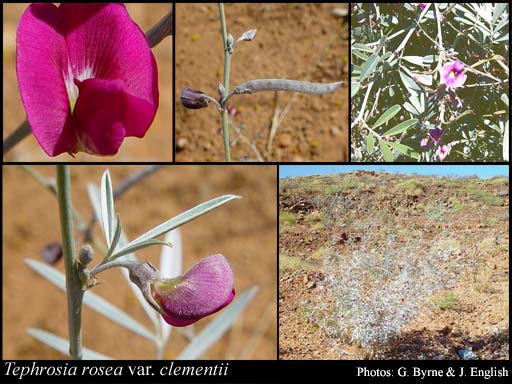- Reference
- Biblioth.Bot. 89:201 (1926)
- Conservation Code
- Not threatened
- Naturalised Status
- Native to Western Australia
- Name Status
- Current
Shrub, to 1.8 m high. Fl. pink-purple-violet, Apr to Aug or Oct. Red-yellow sand, pebbly loam. Near watercourses, rocky slopes, gravel pit, dunes.

Scientific Description
Erect, shrub, spindly shrub (broom-like). Stems terete, not spiny, glabrous; pustules or glands absent. Leaves or phylloclades clearly present, compound, alternate, continuous with stem, 20-90 mm long, hairy, with simple hairs, flat with flat margins; margins entire; tubercles absent, leaflets 5-9, pinnately arranged, terminal leaflet present, stalked; pustules or glands absent. Stipules present and persistent to older leaves, 4 mm long, without glands, ribless. Pedicel present, 3-5 mm long, hairy. Bracteoles present and persistent. Calyx 4-5.5 mm long, not accrescent, hairy, with simple hairs, ribless; pustules or glands absent. Corolla 7-11 mm long, multicoloured, mostly yellow, pink or purple, with some yellow, pink or purple spots, streaks or blotches; claws present; standard 7-10 mm long, hairy at least in part, not auriculate, wings 7.5-9 mm long, not auriculate, keel 7-8 mm long, not beaked, not auriculate, glabrous. Stamens ten; anthers 0.5-0.6 mm long, at two different levels (filaments alternately long and short); filaments united in an open sheath with one free stamen, 7-7.5 mm long. Ovary sessile or subsessile, hairy or glandular; style 7.5-9 mm long, hairy or glandular towards the base, not bearded, flattened at apex. Fruit dehiscent (a pod or follicle), 25-35 mm long, 3-4 mm wide, sessile or subsessile, constricted between the seeds, round in cross-section, hairy, with simple hairs, not beaked. Flowers in April, May, June, July, August and October. Occurs in the Northern and Eremaean Botanical Province, in the Great Sandy Desert, Pilbara, Carnarvon, Gascoyne, Little Sandy Desert, Northern Kimberley, Ord-Victorian-Plain, Tanami and Dampierland IBRA regions.
Distribution
- IBRA Regions
- Carnarvon, Dampierland, Gascoyne, Great Sandy Desert, Little Sandy Desert, Northern Kimberley, Ord Victoria Plain, Pilbara, Tanami.
- IBRA Subregions
- Ashburton, Augustus, Cape Range, Chichester, Fitzroy Trough, Hamersley, Mackay, McLarty, Mitchell, Pindanland, Purnululu, Roebourne, Rudall, South Kimberley Interzone, Tanami Desert, Wooramel.
- IMCRA Regions
- Pilbara (nearshore).
- Local Government Areas (LGAs)
- Ashburton, Broome, Carnarvon, Derby-West Kimberley, East Pilbara, Exmouth, Halls Creek, Karratha, Port Hedland, Upper Gascoyne, Wyndham-East Kimberley.